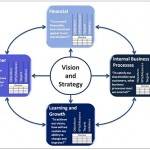ERP Systems, the Balanced Scorecard and KPIs

In today’s business environment, there has been a global trend towards integrating business processes and company strategies with Enterprise Resource Planning systems. Many studies have explained that Enterprise Resource Planning systems, ERP for short, can increase a company’s competitive advantage in the information technology era.
Advantages of Enterprise Resource Planning systems
There are two benefits that can be obtained from ERP implementation efforts, which are classified into tangible and intangible benefits.
Tangible benefits include reduction of inventory, reduction of personnel, increased productivity, improvements in order management and many more.
Intangible benefits refer to the increased visibility of corporate data, new or improved business processes, improved responsiveness to customers, improved communication and so forth. Despite these significant benefits, one major problem is that ERP systems cannot measure the performance impact which these systems have on companies.
As American analytics expert Thomas H. Davenport pointed out, many companies failed to consider whether the system they were evaluating will match their overall business strategy.
ERP – BSC – KPIs

Many studies tried to identify the critical factors influencing the successful implementation of ERP systems.
In one research, professors Jaideep Motwani, Ram Subramanian and Pradeep Gopalakrishna applied a case study methodology to compare a successful and unsuccessful ERP implementation, finding that the main factors behind a successful implementation consisted of cautious, evolutionary, bureaucratic implementations, backed by careful change management, network relationships and cultural readiness.
Regardless, since we know that the business environment generally is characterized by a high level of uncertainty, the process of ERP system assessment involves numerous problems. Because implementation is a complex process, businesses that are implement it successfully need to carefully examine all factors relating to increased operational efficiency.
Constructing a systematic and holistic performance framework, to assess ERP implementation efforts, is therefore essential to subsequent decision-making. Evaluators frequently adopt the common ERP evaluation criteria as performance indicators, without developing a few that include cross-function analysis and cross-functional measurement. One solution that can be adopted is to use both the Balanced Scorecard and KPIs as ERP Performance Measurements.
The Balanced Scorecard provides the quantitative and qualitative basis to a complex decision-making process, in which high-tech firms need to measure ERP performance against multiple criteria.
Kaplan and Norton indicated that the original Balanced Scorecard turned business strategies into measurable indicators. The Balanced Scorecard provided a series of performance measurement indicators that could be utilized to guide objectives and the strategic direction of a company.
The four dimensions of the Balanced Scorecard-based ERP performance measurement system are as follows:
- Financial perspective: the goal of the system is to reduce costs and improve return on investment, ROI for short;
- Customer perspective: the main functions of ERP implementation are to meet customer needs more effectively and eventually increase customer satisfaction;
- Innovation and learning perspective: the goal of the system is to teach employees how to use the system;
- Internal business process: one of the more widely discussed issues is the need for an ERP-based process to fit business and process changes; as such,improving business process efficiency is one of the most important tasks for an ERP system.
Measurements and indicators

Organizations can’t manage what they don’t measure. Thus, during the implementation process, functional teams will need to define which metrics – e.g. key performance indicators or KPIs, they intend to measure, in order to determine the success of their ERP project.
An ERP implementation should help the organization improve performance as measured by KPIs. Organizations need to find KPIs that reflect strategic value drivers rather than just measuring non-critical business activities and processes.
Key Performance Indicators define a set of values, whether they are target values or goals, used to measure performance, and they can be collected on paper or uploaded online, into a system. They can also be grouped in various ways, based on their core characteristic:
- Action based indicators: these are triggers that measure changes in the overall management of an organization;
- Value based or quantitative indicators: a measurable, quantitative value, represented by a number;
- Status or directional indicators: it specifies whether an organization or an employee is improving or not; it describes the direction (up, down) of the status-quo.
- Financial indicators: used in performance measurement and when looking at an operating index;
- Process-based or practical indicators: these indicators are related to business processes.
As a conclusion, ERP implementation can improve a company’s performance levels, as long as it can be measured with the right tools. The Balanced Scorecard and Key Performance Indicators (KPIs) are two of examples of tools that can be used to achieve just that.
ERP systems can be made much more successful by designing the right Scorecard and/or choosing the right KPIs for each scenario.
Image sources:

Tags: Balanced Scorecard, KPI, Resources performance




